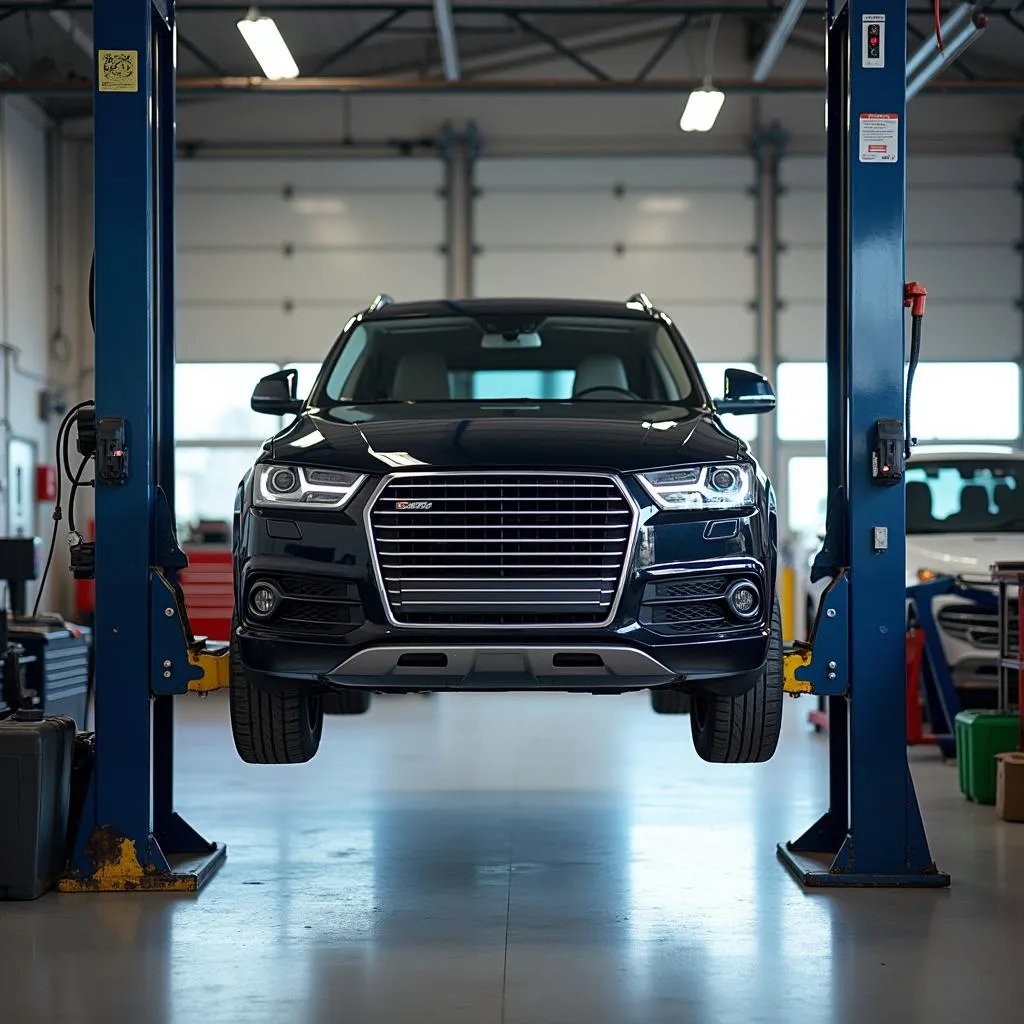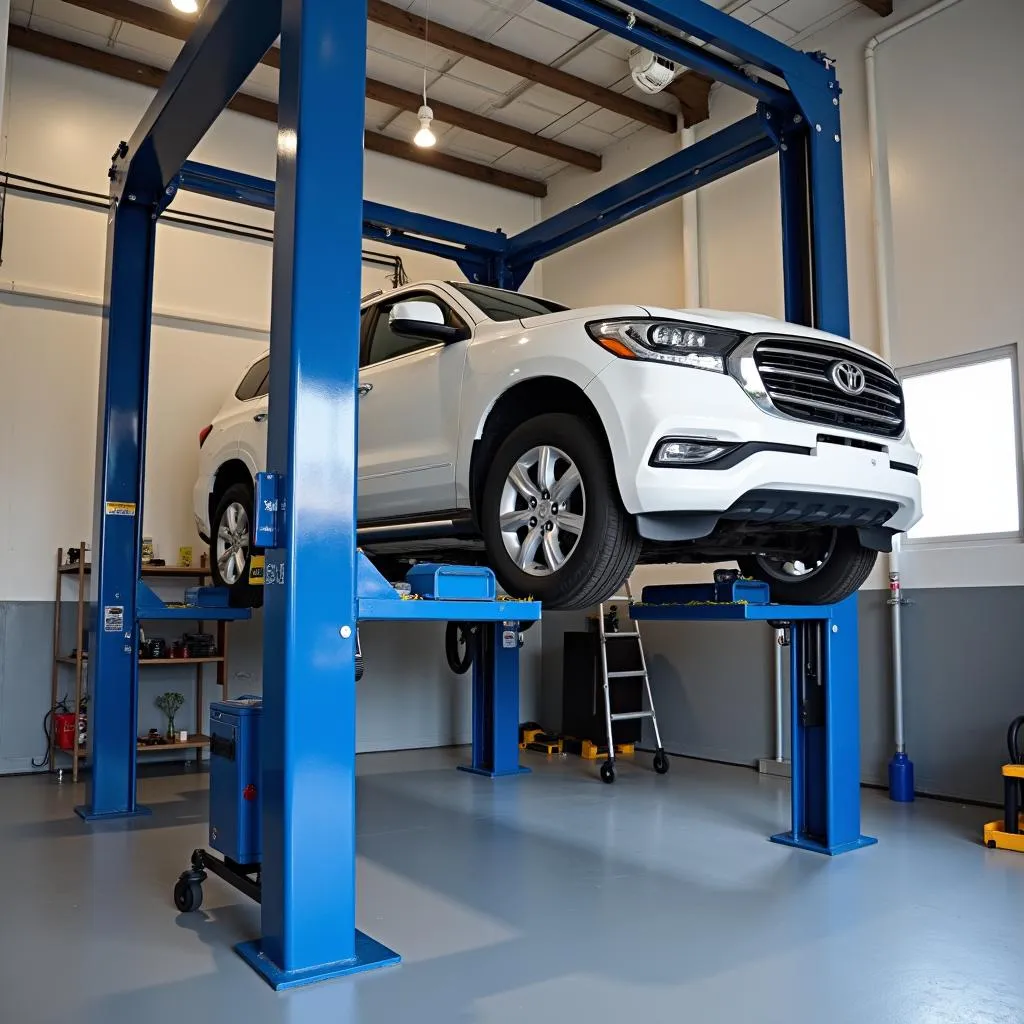When equipping an auto service shop, few decisions are as crucial as choosing the right auto lift. It’s a major investment that impacts workflow, technician safety, and ultimately, your bottom line. But with countless brands and models on the market, how do you determine which lift is best suited for your shop’s specific needs? This comprehensive guide delves into the world of auto lifts, exploring the types preferred by service shops and the factors to consider before making this critical purchase.
 Two-post car lift in a service shop
Two-post car lift in a service shop
Understanding the Different Types of Auto Lifts
Navigating the world of auto lifts begins with understanding the available options. Each type caters to specific vehicle sizes, lifting capacities, and service applications.
1. Two-Post Lifts: The Workhorse of the Shop
Two-post lifts are the backbone of most service shops due to their versatility, affordability, and space efficiency. These lifts use two vertical columns to raise vehicles, providing excellent undercarriage access for a wide range of repairs and maintenance tasks.
Why service shops prefer them:
- Versatility: Suitable for a wide range of vehicles from compact cars to light trucks.
- Space Optimization: Their relatively compact footprint maximizes floor space.
- Cost-Effectiveness: Generally more affordable compared to other lift types.
2. Four-Post Lifts: Stability and Alignment Services
Four-post lifts offer unparalleled stability, making them ideal for heavier vehicles and alignment services. These lifts utilize four vertical columns for support, allowing technicians to perform wheel alignments, suspension work, and other tasks that require a level lifting platform.
Why service shops choose them:
- Stability: Provide a secure platform for working on heavier vehicles.
- Alignment Capabilities: Designed to accommodate alignment equipment.
- Ease of Use: Vehicles are driven directly onto the lift, simplifying the process.
 Car on a four-post lift for alignment
Car on a four-post lift for alignment
3. Scissor Lifts: Low-Ceiling Solutions and Quick Tasks
Scissor lifts are known for their low profile and compact design, making them perfect for shops with limited ceiling height. These lifts use a hydraulic scissor mechanism to raise vehicles, providing convenient access for tire rotations, brake work, and other quick jobs.
Why they’re a valuable addition:
- Space Saving: Ideal for shops with low ceilings.
- Portability: Some models offer portability for added convenience.
- Quick Lifting: Fast lifting speeds for efficient service.
Key Considerations When Choosing an Auto Lift
Selecting the right auto lift involves more than just the type. Here are the essential factors that should guide your decision:
1. Lifting Capacity: Matching the Lift to Your Workload
The lifting capacity of an auto lift is arguably the most critical consideration. It determines the weight of vehicles your shop can safely handle.
Key Points:
- Analyze your current and projected workload.
- Consider the types of vehicles you service most frequently.
- Opt for a lift with a capacity that exceeds your typical needs to allow for future growth.
2. Safety Features: Prioritizing Technician Well-being
Auto lifts are powerful pieces of equipment, and safety should always be a top priority. Look for lifts equipped with essential safety features to mitigate risks and ensure a secure working environment for your technicians.
Features to consider:
- Locking mechanisms: Prevent accidental lowering of the lift.
- Safety shut-offs: Automatically stop the lift in case of malfunctions.
- Emergency lowering systems: Enable safe lowering during power outages.
3. Space Constraints: Optimizing Shop Floor Layout
Before investing in an auto lift, carefully assess your shop’s available space, considering not just the lift’s footprint but also clearance requirements for vehicle doors, technician movement, and equipment access.
Think about:
- Ceiling height.
- Column placement in relation to work areas.
- Drive-through clearance.
 Mechanic working under a lifted car
Mechanic working under a lifted car
4. Budget and Long-Term Value: Balancing Cost and ROI
While it’s tempting to focus solely on the initial purchase price, consider the long-term value and return on investment (ROI). A high-quality auto lift might require a higher upfront investment but can offer significant savings over time through increased efficiency, reduced maintenance costs, and enhanced technician productivity.
5. Brand Reputation and Support: Choosing a Reliable Partner
Opt for reputable auto lift manufacturers known for their product quality, reliability, and customer support. Research different brands, read reviews, and consider factors like warranty coverage, parts availability, and technical support when making your decision.
Expert Insights:
“Choosing the right auto lift is one of the most impactful decisions a shop owner can make,” says John Smith, a veteran auto service technician with over 20 years of experience. “It’s not just about lifting a car; it’s about creating a safe and efficient workspace for your team.”
He adds, “Don’t underestimate the importance of a reputable brand with a strong track record of reliability and excellent customer support. It can make all the difference when you encounter issues or require technical assistance.”
Conclusion: Elevating Your Shop’s Performance
Choosing the right auto lift is paramount to the success of any auto service shop. By carefully assessing your needs, prioritizing safety, and selecting a reputable brand, you can make an investment that enhances productivity, improves safety, and contributes to your shop’s long-term growth. Remember, the best auto lift for your shop is the one that aligns perfectly with your specific requirements and empowers your technicians to deliver exceptional service.


